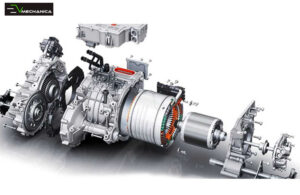 Named as the heart of an electric vehicle, the EV powertrain is responsible for taking energy stored in the vehicle’s battery system and supplying it to the motors.
Named as the heart of an electric vehicle, the EV powertrain is responsible for taking energy stored in the vehicle’s battery system and supplying it to the motors.
An EV’s powertrain system is aimed to generate the energy from its power source through a conversion device and then deliver it to the wheel this process makes a vehicle run.
Generally, the amount of power it takes to move a fully loaded vehicle is enormous, and thus delivery needs to be instantaneous and predictable.
Apart from this, any vehicle’s range is mostly dictated by the ability to provide power with maximum efficiency and minimum resistance it encounters while working.
And this efficiency is what made all the difference between safety, for either making it to your destination or getting stranded on the roadside.
If you want a detailed account of EV Powertrain Manufacturers, you can check out my previous article “EV Powertrain & its Parts Manufacturers in India- Best 5”
However, to understand All About EV Powertrain System and Components, let’s check out some of the most basic parts of electric vehicles that make up the powertrain system.
All About EV Powertrain System and Components
Slated to power electric vehicles, EV Powertrain System and Components are categorized into the below-mentioned parts.
Body Control Module (BCM)
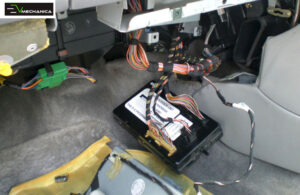 Majorly responsible for not only controlling but also supervising the functions and role of the electronic accessories used, BCM monitors functions like vehicle access control, mirrors, power windows as well as security. Hence coming under the major EV Powertrain System and Components.
Majorly responsible for not only controlling but also supervising the functions and role of the electronic accessories used, BCM monitors functions like vehicle access control, mirrors, power windows as well as security. Hence coming under the major EV Powertrain System and Components.
Battery Packs
Another name in EV Powertrain System and Components, battery packs is made up of not one but multiple cells of lithium-ion that stores the energy which is needed to run the vehicle.
It also offers direct current output (DC output). Some of the major companies that produce battery packs for EVs are Tesla, Panasonic, LG Chem, and CATL.
High-Voltage Wiring
Counted as another part of EV Powertrain System and Components, high-voltage wiring inside the vehicle connects the various components of the powertrain, including the battery pack, the inverter, and the electric motor.
Specifically designed to carry high voltage and current, the wring is required for the efficient operation of the electric motor. Major companies that produce high-voltage wiring for EVs include Sumitomo Electric, TE Connectivity, and Delphi Technologies.
DC-DC Converter
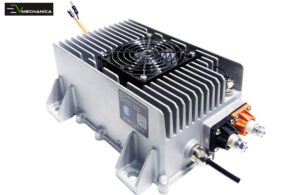 After the pack of the battery gives off a fixed voltage, a DC-DC converter is required for accessory systems such as mirror control, wipers, infotainment system, and lights in the EVs.
After the pack of the battery gives off a fixed voltage, a DC-DC converter is required for accessory systems such as mirror control, wipers, infotainment system, and lights in the EVs.
Deemed an essential part of EV Powertrain System and Components, the DC-DC converter helps in distributing the power to various accessories but also helps in converting the power from the pack of batteries to the required level. And when these conversions are done, power is delivered to Electronic Control Units (ECUs) through a wiring harness.
Thermal Management System
Thermal Management System is mainly responsible for maintaining the optimum desirable operating temperature range for the multiple other EV Powertrain System and Components. Some of the key companies dealing in thermal management systems for EVs include LG Chem, Valeo, and Denso.
DC to AC Converter
Once the necessary power supplied by the pack of batteries is in DC, it gets converted to AC to supply the electronic motor. This fast transfer and conversion of power are supervised and managed by a motor control mechanism also popularly known as the Powertrain Electronic Control Unit.
This part of EV Powertrain System and Components is responsible to control and supervise voltage’s magnitude and frequency supplied to the electric motor which then manages the acceleration and speed of the vehicle according to the orders of the driver through acceleration and brakes.
Battery Management System
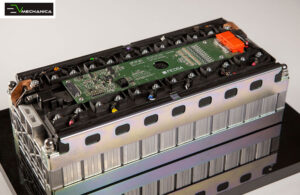 Considered the key part of EV Powertrain System and Components, BMS takes necessary measures in case of a malfunction while continuously monitoring the condition of the battery. To get maximum efficiency and effectiveness from the battery, BMS performs cell balancing as well as checks the current amount of charge.
Considered the key part of EV Powertrain System and Components, BMS takes necessary measures in case of a malfunction while continuously monitoring the condition of the battery. To get maximum efficiency and effectiveness from the battery, BMS performs cell balancing as well as checks the current amount of charge.
It also shares data about the battery’s condition with ECUs, Electric Vehicle Supply Equipment (EVSE), and sensors to take control of the charging input.
On-Board charger
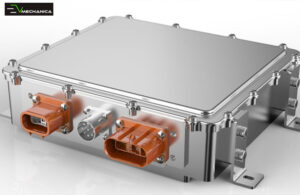 On board charging port offers AC input that converts to DC to control the quantity of charge flowing into the battery. Taking the core parts aside, there are various software and hardware components in an EV. ECUs or Electronic Control Units are software programs that are developed to integrate with powertrain components for better data exchange and processing.
On board charging port offers AC input that converts to DC to control the quantity of charge flowing into the battery. Taking the core parts aside, there are various software and hardware components in an EV. ECUs or Electronic Control Units are software programs that are developed to integrate with powertrain components for better data exchange and processing.
Electric Motor
Known as the key part of EV Powertrain System and Components, the electric motor is utilized in EVs for the role of regeneration, which converts electrical energy to mechanical energy.
In turn, this converted mechanical energy is then made available to the wheels through single-ratio transmission. Key companies manufacturing electric motors for EVs range from Tesla, General Motors, and BMW.
